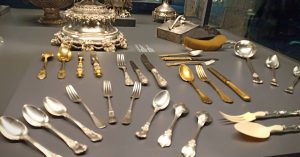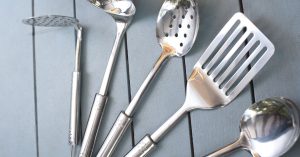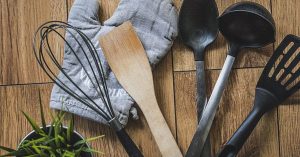If you’ve ever made the mistake of putting your aluminum KitchenAid mixer attachments in the dishwasher, you’ll understand the frustration of dealing with oxidized utensils. It’s awful when you handle them and end up with black and gray streaks all over your hands and even on your food.
But don’t worry, there’s a simple “how to fix oxidized kitchen utensils” that I want to share with you. It’s as easy as boiling water. I’ve had my fair share of reminding the kids not to put my KitchenAid attachments in the dishwasher.
The detergent wreaks havoc on them, causing the aluminum to oxidize and leave those annoying streaks everywhere.
How To Fix Oxidized Kitchen Utensils: To remove discoloration on aluminum utensils, boil a solution of cream of tartar, lemon juice, or vinegar in water for 5 to 10 minutes. Lightly scour with a soap-filled pad.
Quick Navigation
How To Fix Oxidized Kitchen Utensils: Steps
To fix oxidized kitchen utensils, follow these steps:
Step 1: Gather the necessary supplies
Before starting the process of fixing oxidized kitchen utensils, gather the following supplies: warm soapy water, a scrub brush or sponge, baking soda, water, vinegar or lemon juice, and a towel for drying. Having these supplies ready will make the cleaning process easier and more efficient.
Step 2: The cleaning process
- Begin by filling a sink or basin with warm soapy water.
- Submerge the oxidized utensils in the water and let them soak for a few minutes. This will help loosen any loose oxidation or debris.
- Take a scrub brush or sponge and gently scrub the utensils to remove the loose oxidation. Be careful not to apply too much pressure to avoid scratching the utensils.
- Rinse the utensils thoroughly with water to remove any soap residue.
Step 3: Applying cleaning agents
- Option 1: Baking soda paste
- In a small bowl, mix baking soda with water to create a paste-like consistency.
- Apply the baking soda paste to the oxidized areas of the utensils.
- Let the paste sit on the utensils for about 15-20 minutes to allow it to work on oxidation.
- Gently scrub the utensils with a scrub brush or sponge to remove the oxidation.
- Rinse the utensils with water to remove any residue from the baking soda paste.
- Option 2: Vinegar or lemon juice
- Fill a container with vinegar or lemon juice.
- Submerge the oxidized utensils in the vinegar or lemon juice and let them soak for about 30 minutes.
- Using a scrub brush or sponge, gently scrub the utensils to remove the oxidation.
- Rinse the utensils thoroughly with water to remove any vinegar or lemon juice residue.
Step 4: Drying and polishing
- After cleaning, towel dries the utensils or let them air dry completely.
- If desired, apply a food-safe oil or polish to the utensils to restore shine and protect them from future oxidation. Follow the instructions provided with the oil or polish for the best results.
By following these detailed steps, you can effectively fix oxidized kitchen utensils and restore their appearance and functionality. Remember to handle the utensils with care and take appropriate safety precautions while cleaning.
Which Pot is Suitable for Repairing Oxidized Utensils?
When fixing oxidized utensils at home, it is recommended to use cookware that is non-reactive. Non-reactive cookware includes options like glass, glazed ceramic, stainless steel, and most non-stick pans (like Teflon). These materials won’t react with the utensils or the cleaning agents used.
On the other hand, reactive cookware like aluminum, copper, iron, and non-stainless steel can react with the utensils or the cleaning solution, causing discoloration or giving off an odd taste. It’s best to avoid using reactive cookware, especially when cleaning utensils that are oxidized.
So, to ensure the best outcome when cleaning oxidized utensils, it’s wise to choose non-reactive cookware.
Does the grayish residue pose any harm?
When burnished aluminum utensils are washed in the dishwasher or soaked in the sink, they may develop a grayish residue due to oxidation. Although it may affect the color of food items mixed with it, this residue is not harmful or dangerous. It is simply a cosmetic issue that can be cleaned to restore the utensils’ appearance.
Preventive Measures for Avoiding Oxidation
Here are some things to preventing measures for avoiding oxidation:
Proper storage techniques:
- Store utensils in a clean and dry environment to prevent moisture buildup.
- Avoid exposing utensils to direct sunlight or extreme temperatures.
- Use protective covers or sleeves to shield utensils from air exposure.
Regular cleaning and maintenance:
- Clean utensils promptly after each use to remove any food residues.
- Hand wash utensils using mild dish soap and warm water.
- Thoroughly dry utensils before storing them to prevent moisture-related oxidation.
Use of protective coatings:
- Apply a food-safe oil or polish to create a protective layer on the utensils.
- Consider using specialized coatings or sprays recommended for specific utensil materials.
- Reapply protective coatings periodically as needed to maintain their effectiveness.
FAQs:
Q:1 How can oxidized mixer attachments be fixed?
To remove oxidization from KitchenAid mixer attachments, soak the beater in hot soapy water and scrub with a nylon scrubber or use a specialized cleaning agent.
Q:2 What is the process to remove oxidation from the KitchenAid mixer?
To remove oxidization from your attachment, place it in a pot with 2 cups of vinegar. Add enough water to cover the attachment’s neck and boil for 20 minutes. Wipe it with a clean dry cloth to remove the residue. Repeat if necessary.
Q:3 Which cleaning agent is specifically designed to remove oxidation?
Kracken Wash is a unique formula for removing oxidation from painted surfaces like vinyl or aluminum. Simply downstream a 10:1 mix onto the surface to unleash the Kraken.
Conclusion:
In conclusion, by following the steps outlined and taking preventive measures, you can effectively fix oxidized kitchen utensils.
Proper cleaning, using appropriate cleaning agents, and employing preventive measures such as proper storage and regular maintenance will help maintain the longevity and appearance of your utensils.
Remember to handle the utensils with care and prioritize safety throughout the cleaning process.
By reading this article, you should now know how to fix oxidized kitchen utensils. If you have questions, please comment below!




